Pump Handbook by Igor J. Karassik, Joseph P. Messina, Paul Cooper, Charles C. Heald - 3rd edition
Подождите немного. Документ загружается.


Pump
Drivers
C•H•A•P•T•E•R•6

SECTION 6.1
PRIME MOVERS
6.1.1
ELECTRIC MOTORS
AND MOTOR CONTROLS
A. A. DIVONA
A. J. DOLAN
J. R. HENDERSHOT
6.3
The two most common types of electric motors are alternating current (ac) induction and
direct current (dc) commutated shunt- or series-wound. All electric motor configurations
except one type (reluctance brushless) convert electrical energy to mechanical energy from
the magnetic flux linkage of their two magnetic circuits. One of these circuits is in the sta-
tor and the other is in the bearing-mounted rotor. This flux linkage between the two mag-
netic circuits produces a moment of force at the rotor radius that results in a torque on the
motor shaft causing shaft rotation. The speed of the rotation times the torque equals the
output power at the motor shaft. This is, of course, the power used to drive a pump.
The basic difference between these two types of electric motors has to do with their
electrical power source.The first type has been historically powered by 60 cycle (Hz) alter-
nating voltages direct from the public utility power grid (50 Hz in most of Europe and
some other parts of the world). For this type of motor, the speed is determined by the num-
ber of magnetic poles designed in the motor and the alternating sinusoidal frequency of
the voltage from the power grid. Methods have been developed to alter the speed of an ac
motor with a fixed number of poles and a fixed line frequency (it is also possible to wind
such a motor with several poles for other speeds). However, the squirrel-cage induction
motor remains without question the most common type of motor used to drive pumps.The
reasons for this are worldwide availability, excellent reliability, excellent performance
characteristics, and ease of replacement.As the pump industry continues to adopt variable
speed motor/drives, the ac induction motor will likely continue to be by far the number one
prime mover for most all types of pumps.This is also because of its adaptability to variable
speed using ac inverters and vector drives.
The other motor type currently in use to drive pumps is the dc motor. Most of these
applications are in the smaller sizes such as automotive and off road equipment.The over-
all use of dc motors for pump drives is predicted to decline.
The dc type of electrical machine also contains two magnet fields, one in each of the sta-
tor and rotor assemblies of the motor. Although the dc motor does not operate for its entire

6.4 CHAPTER SIX
useful life without maintenance on the mechanical brushes and commutator, it is still
selected for some pump applications when only a dc voltage power source is available. It
has been also selected in a limited number of instances where adjustable speed is
required. The dc motor, powered by the voltage from storage batteries or from a dc gener-
ator, can be speed-adjusted by varying the voltage with a power supply. Its speed rela-
tionship to the voltage is linear and very useful for some pump applications such as
constant displacement types, which require speed adjustment to set flow. [See Subsection
6.2.2.]
The more recent availability of permanent magnet brushless dc motors should offer a
more reliable prime mover for these applications, with superior performance and long life
benefits.
There are other types of electric motors considered for driving pumps. The reasons for
this include the dramatic recent advances in power electronics and microprocessors,
advances in motor materials such as permanent magnets, and advances in the pumps
themselves. Besides the active interest in adjustable speed pumps, another reason for the
interest in some newer motor types for pump applications is because of recent U.S. gov-
ernment regulations enacted to improve energy conservation by implementing motor effi-
ciency mandates along with a time schedule. For example, the U.S. Energy Policy and
Conservation Act of September 10, 1992 (EPACT) stipulates that all covered electric motor
products must meet the efficiency levels per NEMA MG1 1993. The requirement covers all
electric motors from 1–200 horsepower (1–150 kW) manufactured after October 24, 1997
that operate from 230/460 VAC power at 60 Hz line frequency. The U.S. Department of
Energy approved test method to meet the new efficiency levels is per IEEE-112B. This reg-
ulation was originally intended for ac induction motors.
For those pump applications that require the motor torque to increase as the square of
speed, these new, more efficient motors will run at higher speeds because their slip is less.
This could cause an appreciable increase in overload within the motor. Overload could also
result in other mechanical parts of the system.There are other ramifications resulting from
these new requirements that must be carefully analyzed when selecting an electric motor,
starter, or inverter. The resulting analysis might very well cause the selection to be some
other electric motor type, such as a permanent magnet brushless dc, permanent magnet ac,
synchronous (sine wave driven version of the brushless dc), or even a switched reluctance
brushless dc motor. Each of these types must be powered with an inverter and a controller.
However, the result can most likely offer adjustable speed with a very high efficiency over
a wide speed range. This use of an inverter is required for each of those other types of
motors mentioned. With the availability of the new vector controlled ac inverters (Section
6.2.2), the high-efficiency ac induction motor can also be applied for variable speed. This
will eliminate the need for a soft starter frequently required with line fed motors.The elim-
ination of the starter helps somewhat to offset the additional cost of the inverter.
TYPES OF MOTORS __________________________________________________
Alternating-Current Motors
SQUIRREL-CAGE INDUCTION MOTOR By far the most common motor used to drive pumps is
the squirrel-cage induction motor (Figure 1). This motor consists of a conventional stator
wound with a specific number of poles and phases, and a rotor that has either cast bars
or brazed bars imbedded in it.
The squirrel-cage induction motor operates at a speed below synchronous speed by a
specific slip or revolutions per minute. The synchronous speed is defined as
where N speed, rpm
f line-power frequency, Hz
p number of poles
N
f 60 2
p
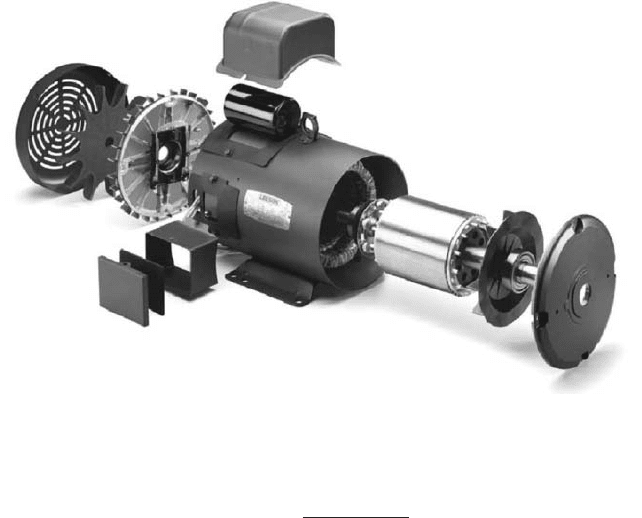
6.1.1 ELECTRIC MOTORS AND MOTOR CONTROLS 6.5
FIGURE 1 Exploded view of a typical squirrel-cage induction motor (Courtesy of Leeson Electric Corp.)
The percent slip is defined as
where s slip, rpm
When the stator winding of a squirrel-cage induction motor is connected to a suitable
source of power, a magnetic flux is generated in the air gap between the stator and rotor
of the motor. This flux revolves around the perimeter of the air gap and induces a voltage
in the rotor bars. Because the rotor bars are short-circuited to each other at their ends (end
rings), a current circulates in the rotor bars. This current and the air-gap flux interact,
causing the motor to produce a torque.
The squirrel-cage induction motor exhibits a characteristic speed-torque relationship
that is determined by the resistance of the rotor bars.Thus, the desired speed-torque char-
acteristics are obtained by selecting a metal of suitable resistance when designing the
rotor bars.The slot shape and size for the bars in the rotor can be selected to achieve a cer-
tain rotor resistance.
Figure 2 suggests several typical speed-torque characteristics that have been stan-
dardized by NEMA (National Electrical Manufacturers Association), covering motor
frames 143T through 449T. Motors larger than 449T may not have these same values, but
generally have the same characteristic curves. Also, single-phase motors may not exhibit
these characteristics and are defined specifically by NEMA with different values.
Most pumps are driven by NEMA B characteristic motors when operated from three-
phase power sources.
WOUND ROTOR INDUCTION MOTOR The wound-rotor induction motor is in every respect sim-
ilar to the squirrel-cage version except that the rotor is wound with insulated wire turns
and this winding is terminated at a set of slip rings on the rotor shaft. Connections are
made to the slip rings through brushes and in turn to an external resistor, which can be
adjusted in ohmic value to cause the motor speed-torque characteristics to be changed.
These types of motors have been used in some pump applications in the past, but due to
% slip
1N s2 100
N
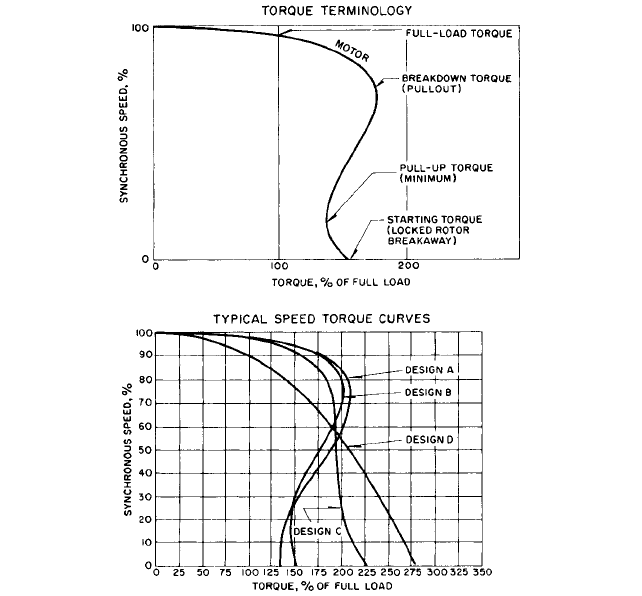
6.6 CHAPTER SIX
FIGURE 2 These curves are characteristic of NEMA frame size squirrel-cage induction motors through size 449T
(typically through 300 hp–224 kW).
the availability of inverter-fed ac squirrel-cage induction motor drives, they are no longer
very practical.
Figure 3 demonstrates the speed-torque characteristics of a wound-rotor induction
motor for several resistor values. It will be noticed that increasing the external resistance
of the control will cause the peak torque of the motor to be developed at lower speeds until
the peak torque occurs at zero speed. Increasing the resistance beyond this value will
cause the motor to have a limited torque as, for example, curves 4, 5, and 6. This motor can
be used where torque control is required or where variable speed is necessary. In the vari-
able-speed application, the rotor resistance is adjusted to produce a motor torque that
matches the load torque at the specific speed desired.This system is not as useful and cost-
effective as an inverter-fed ac induction motor due to the recent developments of power
electronics and microprocessors.
SYNCHRONOUS MOTOR The synchronous motor is also similar to the squirrel-cage induc-
tion motor except that it operates at synchronous speed and its rotor is constructed with
definite salient poles on which a field coil is wound and connected to a source of direct
current for excitation. The most common synchronous motor is constructed with slip rings
on the rotor shaft to connect the dc excitation to the field coils.
There are various means of providing the dc power to the slip rings:
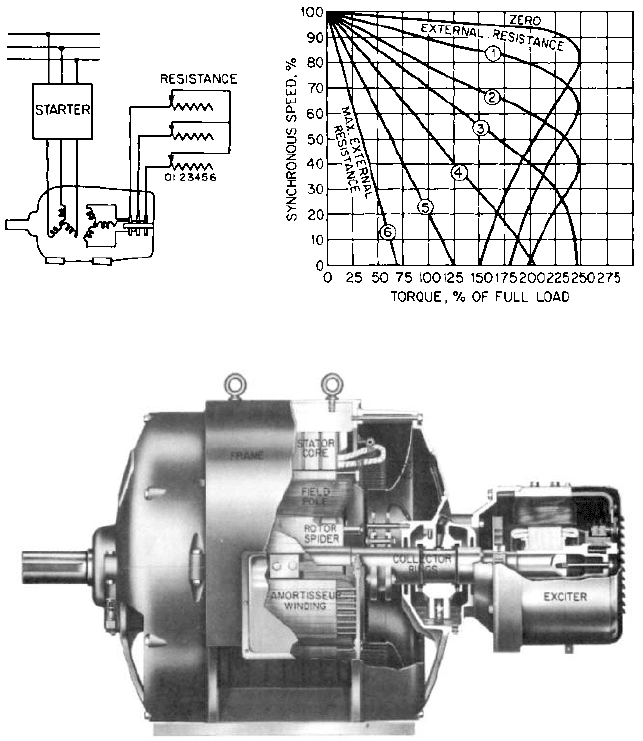
6.1.1 ELECTRIC MOTORS AND MOTOR CONTROLS 6.7
FIGURE 3 Typical speed-torque characteristics of a wound-rotor induction motor (Westinghouse Electric)
FIGURE 4 Synchronous motor with direct-connected exciter (Electric Machinery Manufacturing)
1. Static excitation The power to be connected to the slip ring brushes on the motor
shaft is obtained from a transformer and rectifier package external to the motor.
2. Direct-connected exciter This arrangement has a dc generator directly connected
to the synchronous motor shaft (Figure 4). The dc power from this generator is con-
nected to the brushes of the synchronous motor slip rings.
3. Motor-generated exciter The dc power for exciting the synchronous motor is gen-
erated by means of a remote motor-generator set operating from normal ac power, and
the dc voltage from this motor-generator set is connected to the brushes of slip rings
of the synchronous motor.
Another form of synchronous motor is known as the brushless synchronous motor (Fig-
ure 5). As the name implies, this motor has its rotating field excited without the use of slip
rings for connecting the external direct current to the motor field. The construction of this
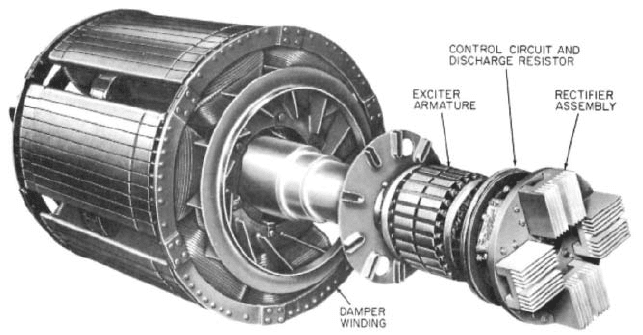
6.8 CHAPTER SIX
FIGURE 5 Brushless synchronous motor with ac generator mounted on the shaft with rectifier and control
devices (Electric Machinery Manufacturing)
motor incorporates a shaft-connected ac generator. The field of the ac generator is physi-
cally stationary and connected to a source of dc voltage. The rotor of this ac generator is
connected through a solid-state controlled rectifier mounted on the synchronous motor
rotor and in turn connected to the synchronous motor field. This arrangement facilitates
a connection between external excitation power and the rotating field of the synchronous
motor through the air gap of the shaft-connected ac generator. The brushless synchronous
motor has many advantages over the conventional slip-ring synchronous motor. Among
these are the elimination of brushes and slip rings, which are high-maintenance items; the
elimination of sparking devices, which are not permissible in certain atmospheres; and the
use of static devices for field control, which are more reliable than conventional electro-
magnetic controls.
Synchronous motors are used for pump applications requiring larger horsepower rat-
ings at lower speed conditions, as illustrated in Figure 6. Also, they are used on applica-
tions where a high power factor or a power-factor-correction capability is desired. Of less
importance is the characteristic of the synchronous motor that it will always operate at
synchronous speed (does not have a slip) regardless of load. Synchronous motors are
started on their damper windings (the same as squirrel-cage induction motors), and when
they have accelerated to within 5% of synchronous speed, the field is applied and the
motor accelerates to synchronous speed (Figure 7).Typical characteristic curves are shown
in Figure 8.
Direct-Current Motors Dc motors are only occasionally used to drive pumps. Most of
the current applications for dc pump drives are in some form of automobile or off-the-road
equipment due to the dc power from storage batteries. There are some other situations
that might call for dc motor pump drives such as shipboard duty, railway applications,
aircraft, mining installations, and some other emergency battery operations.
There are three types of dc motors available (Figure 9): shunt, series, and compound-
connected.
Larger horsepower ratings of shunt-wound dc motors are frequently qualified as “stabi-
lized shuntwound” motors and incorporate a series field similar to that of a compound
wound motor. This is necessary to adjust the regulation of the shunt motor so as not to
exhibit a rising speed-torque characteristic. It is important to be aware of the speed at which
a dc motor will operate on pump applications because of pump performance guarantees.
The windings in the stators of the wound types are connected to the armature windings
through brushes and a commutator three different ways to achieve different performance
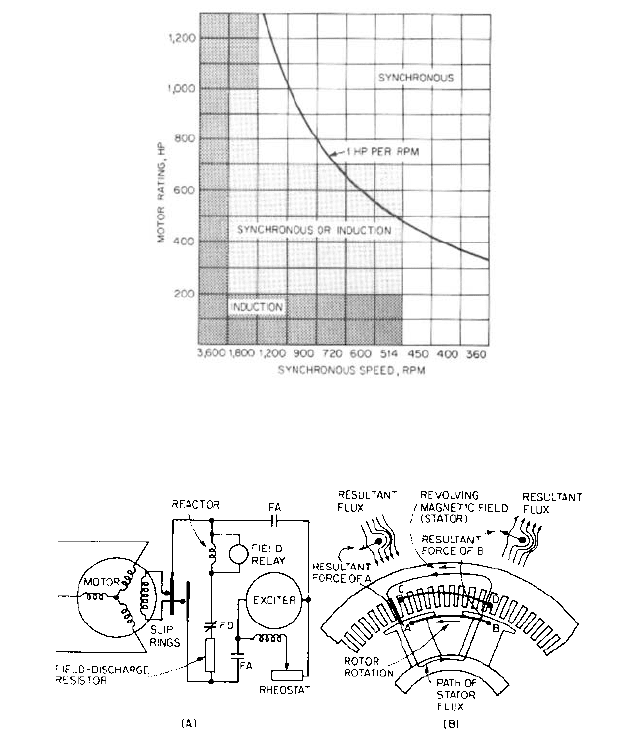
6.1.1 ELECTRIC MOTORS AND MOTOR CONTROLS 6.9
FIGURE 6 Below 514 rpm, or powers greater than approximately 1 hp/rpm (0.746 kW/rpm), synchronous motors
are a better selection than squirrel-cage induction motors because higher cost can generally be offset by higher
power factor and efficiency (from Power special report, “Motors,” June 1969).
FIGURE 7 Method of starting synchronous motor. (A) Typical field control (brush type) energizes the dc field to
pull the rotor into synchronism as it comes up to speed. Field relay senses change in induced frequency as motor
speeds up. (B) Damper winding is similar to a squirrel-cage rotor winding. It produces most of the starting torque,
and the synchronous motor starts with essentially induction-motor characteristics (from Power special report,
“Motors,” June 1969).
characteristics (see Figure 3 for details). With the use of pulse width modulation (PWM)
or silicon-controlled rectifiers (SCR), variable dc power supplies the armature voltage,
which can be controlled along with a separate control for the field current (see Subsection
6.2.2). Using this control scheme, the dc motor can be used to control speed over a very
wide range in a smooth manner. For example, constant voltage can be produced from zero
rpm up to base design speed of the motor by armature control and constant power above
base speed using flux weakening of the armature field. When operating from a constant
voltage, dc motors are available to provide up to a 4 to 1 speed range with an adjustable
dc field power supply. With this separate control scheme for both field and armature, a 100
to 1 speed range is easily achievable. Figure 9 summarizes the various field connection
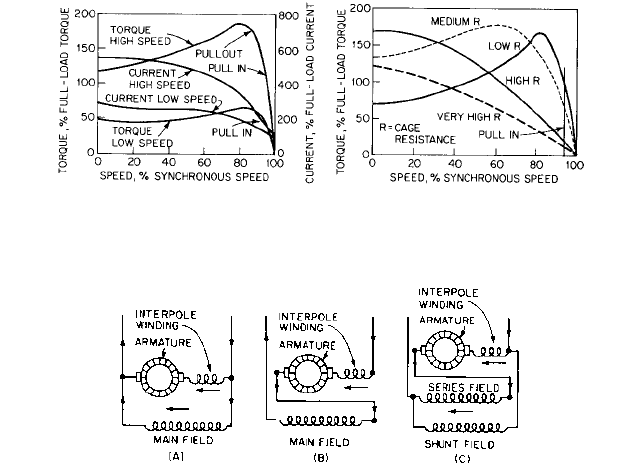
6.10 CHAPTER SIX
FIGURE 8 Characteristics of synchronous motors depend on rotor design. Torque and current relations are
influenced by synchronous speed. High-resistance cage produces high starting torque but low pull-in torque (from
Power special report, “Motors,” June 1969).
FIGURE 9A through C Types of dc motors. (A) Shunt motor has field winding of many turns of fine wire
connected in parallel with the armature circuit. The interpole winding aids commutation. (B) Series motor has field
in series with the armature. Field has a few turns of heavy wire carrying full-motor current flowing in the
armature. (C) Compound motor has both a shunt and a series field to combine characteristics of both shunt- and
series-type motors in the same machine (from Power special report, “Motors,” June 1969).
schemes for dual wound dc machines with mechanical commutation systems. Figure 10
illustrates typical characteristics of the dc motors discussed. Figure 11 shows the equiva-
lent circuit of a permanent magnet type dc motor.
Permanent Magnet (PM) Brushless Motors The permanent magnet brushless dc
motor has been in existence for about three decades and is finally being widely used for
many applications. Its being brushless has frequently been mentioned as justification for
its cost, higher than most other motor types. However, the PM brushless motor has two
other features that are arguably more important than the fact that it contains no mechan-
ical brushes and commutator for commutation of the phase windings to the power source.
First, it produces the highest continuous output power per unit volume of any motor yet
invented. The other important virtue of a PM brushless motor is that it produces its out-
put power with the least input power. For a given size and output performance envelope,
it has the most efficient motor of any electric motor yet invented. With the emphasis on
reducing power consumption, this type of motor will be used in many pump applications.
In addition, and perhaps most importantly for the application of pumps, the PM brush-
less motor posseses one other very important feature or use of the permanent magnets
contained within the rotor assembly. Although the magnets are there to supply a mag-
netic field from the rotor to pass through the air gap of the motor into the stator, these
same magnets can serve as a magnetic coupling. If a sleeve-shaped liquid barrier made
of a suitable material to be impervious to the liquid is fitted between the rotor and sta-
tor, the PM brushless can be used as the best hermetically sealed wet motor known.There
are, of course, many possible configurations of this PM brushless hermetic motor concept.
These PM brushless hermetic motors can be configured as axial gap, radial gap inside

6.1.1 ELECTRIC MOTORS AND MOTOR CONTROLS 6.11
FIGURE 10 Speed, torque, and power characteristics of dc motors (from Power special report, “Motors,” June
1969)
FIGURE 11 The equivalent circuit of a dc motor with a permanent magnet stator
rotor, or radial gap outside rotor motors (Figure 12). The choice depends upon the best
way to design the pump integration.
All PM brushless motors must be powered with an electronic inverter and controller,
which can be used for controlling pump performance in controlled loop systems of all
types. The electronic drive can be a simple square wave, a six-step trapezoid type, or a
sinusoidal drive. Also, some sort of electronic remote or motor mounted shaft position sys-
tem that is no different than that used for an ac induction vector drive is required.
Three permanent magnet choices can be used for these motors.The lowest priced mag-
net material is known as ferrite or ceramic with a magnetic flux output of about one-third
